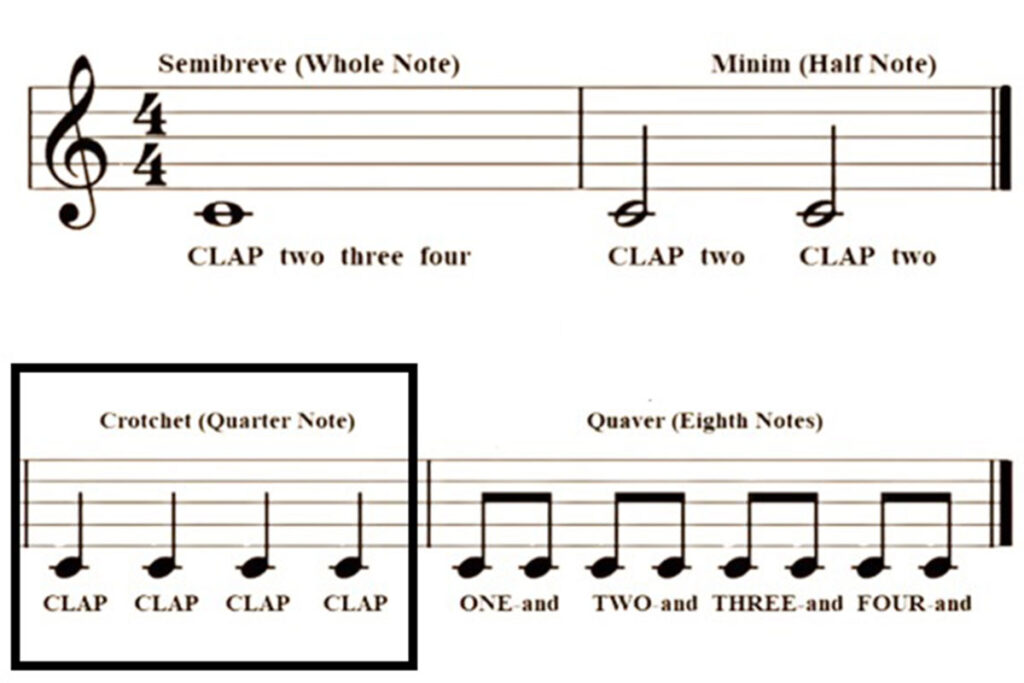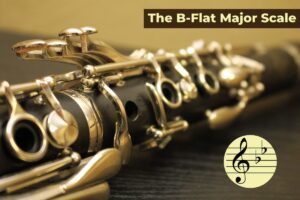
Introduction To Music Notes and Their Time Values
The musical notes are one of the major components of the staff music notation. It has to do with the duration of a tone.
The staff music notation uses musical notes and staff lines. Both are used to denote the pitch and duration of a tone, respectively.
In staff music notation, special symbols are normally used for tone duration. These symbols are the musical notes. They have defined durations or beat values.
Basically, musical tones have different lengths. The lengths are depicted with different symbols known as musical notes.
These music notes and their time value are key to a proper bar line and time signature that set the tone for rhythms in music notation.
The knowledge of musical notes and their time values is one of the aspects of staff music notation. It is also the starting point for learning staff music notation and how to sight-read music.
This post will walk us through the basic knowledge we need to get acquainted with the musical notes and their time values. It will also help us master them.
All we need to do is focus and study each section with internal attention. Without further ado, let’s see what musical notes are and what their time values are.
Musical Notes
The musical note is the major component of written music. In musical notation, the musical notes are represented by special symbols.
The special symbols are used in staff music to denote how long a tone sounds on the staff. Basically, it defined the time value of a tone.
Typically, musical notes symbolize the duration of a sound, and its pitch is defined by the lines of the staff.
Specifically, two things are very important in music. The first is the pitch of a tone. This describes how high or low a note is.
The second is the length of a note. It describes how long or short a tone will sound.
We use lines and symbols called staff and notes, respectively, to write music on paper.
Specifically, for the pitch of the tone, we used lines called staff lines.
Also, for the length or duration of the tone, we used special symbols called musical notes.
Thus, we can define musical notes as special symbols used in music to indicate the sound and its duration.
We need to know the shapes or symbols used as musical notes and their durations, or beat values.
This is necessary to properly master the acts of musical notation and reading.
This will lead us to the next section, where we will look into music note anatomy.
Although musical notes and their time values are not very hard to learn, mastering the essential aspects of them is very important.
This involves knowing all the musical notes’ names and their corresponding note values.
Moreover, one should know the name of every part of the music notes. One should also know how to draw every music note that we have properly.
This is necessary if we want to score some notes manually without using musical notation software.
Musical Notes Anatomy

The musical note consists of either one, two, or three parts (as shown above). These parts are referred to respectively as the head, stem, and flag (or hook).
Firstly, the head of the note is the elliptical (or oval) part of the note.
In particular, it is an oval shape that may be shaded completely or left blank to depict the value of the note.
Secondly, the stem of a note is a line or bar that is attached to the head of the note.
The stem of a note appears on the right side of the head when turned up and on the left side of the head when turned down.
Also, it connects the flag of a note that carries a flag with the head.

Lastly, a musical note’s flag is a little line that comes off the top or bottom of the note stem.
The flag is often called the “tail” (or cross-stroke) and is always on the right side.
Type of staff notes and Their Values

The musical notes and their symbols are used to represent a musical tone or sound.
Notes come in different flavours, each with its own note value or beat duration.
Before we go into detail on each kind of note, have a look at the diagram below. It shows most of the kinds of notes you will encounter in a musical arrangement.
Note that their values add up to the same in each row.
The value of a half note is half of a whole note; the value of a quarter note is a quarter of a whole note, and so on.
From the diagram below, each level of the “tree of notes” is equal to the others.
We have six principal notes that are in common use nowadays and one that is not. These are described in the sections below.
Breve
Breve is represented by a hollow oval note head with no stem, like a whole note, with one or two vertical lines on either side.
It has the time value of eight beats and lasts twice as long as a whole note.
It is also called double whole note.
Play breve for 8 (eight) beats.
Semibreve
Semibreve is represented by an open hollow oval note head, like that of a half note (or minim), and no note stem.
It has the time value of four beats and is equivalent to two half notes or four quarter notes.
It is also called a whole note.
Play semibreve for 4 (four) beats.
Minim
Minim is represented by hollow oval note head like a whole note and straight note stem with no flags like a quarter note. It has a time value of two beats.
It is also called a half note.
Play minim for 2 (two) beats.
Crotchet
Crotchet is represented by a filled-in oval note head and a straight, flagless stem.
It has the time value of a half of a half note or one beat and is indicated by a filled oval with a stem. It’s also called a quarter note
Play crotchet for 1 (one) beats.
Quaver
Quaver is represented by oval, filled-in note head and a straight note stem with one flag.
It has the time value of the half of a quarter note or a half of a beat and is indicated by a filled oval, a stem, and one flag. It’s also called a eighth note.
Play quaver for 1/2 (half) beats.
Semiquaver
Semiquaver is represented by oval, filled-in note head and a straight note stem with two flags. It’s also called a sixteenth note.
Play semiquaver for 1/4 (quarter) beats.
Demisemiquaver
Demisemiquaver is represented by oval, filled-in note head and a straight note stem with three flags. It’s also called a thirty-second note.
Play demisemiquaver for 1/8 (eighth) beats.

The musical piece in common time signature (i.e. 4/4) time, this is also called common time, a whole note will last for four beats count, a half note will last for two beats count, and a quarter note will last one beat count.
An eighth note will last for half a beat and a sixteenth note will just last for a quarter of a beat in 4/4 time.
Writing notes on Staff (Stave)

Whenever you are writing music, know that you are trying to communicate with a reader. So, the legibility is very important.
But in the modern world of today, we can use a software package to write and print a music sheet.
Some of these software are Sibelius, Muse Score, Finale, etc.
However, when we are writing staff notation by hand, we must make it neat.
Thus by using music manuscript, we need to be guided to make our music legible for our readers.
There must be orderliness in the writing of musical notes on the stave.
The major reason for that is to make the reading and playing of music easy.
When only one part (or voice) is written on the staff, the following rules must be applied:
(1) The head of the note must be properly placed on the line or in the space.
(2) If the note head is below the third line, the stem must point up.
(3) If the notehead is above the third line, the stem must point down.
(4) If the note-head is on the third line, the stem can point up or down. Also, we need to take the direction of the flag into consideration as well.
(5) The upward and downward stems are written on the right side of the head.
(6) Ensure stems are properly joined to their note heads and hooks (tails) to their heads.
Beaming of Musical Notes

Notes with flags that are more than one and appear next to each other can also be connected to each other with a beam. This is sometimes called a ligature.
We use beam instead of each note getting a flag.
This is really another, more organized-looking incarnation of the flag. It is better to use beams instead of individual flags on notes.
This is simply a case of trying to clean up an otherwise messy-looking piece of musical notation.
To improve the readability, replace the flags of the notes with beams. The beams will join the notes together into a grouping.
Note that you will replace the single flags with single beams and the double flags with double beams, and so on.
Musical Notes and Beat Counting
Knowing how to count the beat of a note is very important in music reading.
In fact, it is one of the skills that will actually be helpful in all your musical endeavours.
Also, it is very helpful when you want to play or sing with other musicians.
So, learning note values is just a basic need to this end.
What you need to know is how long each note will last before you pause or move on to other notes.
In this section, we will look into ways we can count our beat by using 4/4 time.
To achieve this, we will employ the usage of “numbers” (i.e., 1, 2, 3, 4, etc.) and words (basically “and”).
Also, we need to count the beats out loud with our numbers and words.
And whenever you are counting out the beats, only count as high as the highest-valued note in a selection.
i. Semibreve (Whole Note)

This is a musical note with tone value of four (4) beats. If you were to see a line of whole notes, you would count them out like this:
One (CLAP) – Two – Three – Four – One (CLAP) – Two – Three – Four – One (CLAP) – Two – Three – Four – One (CLAP) – Two – Three – Four
“CLAP” means you clap your hands for one beat, and “two-three-four” is what you say out loud as the note is held for four beats.
ii. Minim (Half Note)

This is a musical note with tone value of two (2) beats measure. A half note will last for half as long as a whole note. Whenever you count out the half notes, it will sound like this:
One (CLAP) – Two – One (CLAP) – Two – One (CLAP) – Two – One (CLAP) – Two
“CLAP” means you clap your hands for one beat, and “two” is what you say out loud as the note is held for two beats.
iii. Crotchet (Quarter Note)

This is a musical note with tone value of one (1) beats measure. Divide a whole note (with a four beats value) by four, and will you get a quarter note with a note value of one beat.
Four quarter notes are counted out like this:
One (CLAP) – Two (CLAP) – Three (CLAP) – Four (CLAP)
You would only count up to one because the highest valued note is a quarter note which is just a beat. A “CLAP” means you clap your hands for one beat.
iv. Quaver (Eighth Notes)

This is a musical note with tone value of half (1/2) beats measure. Absolutely, the eighth note has a value of half of a quarter note.
Eight notes of eighth note (quaver) will last for the same duration as one whole note, which means that an eighth note will last half a beat (in 4/4, or common, time).
Eighth notes can be counted out like this:
Tap your toe for the beat count while you clap your hands twice for every toe tap you make.
One (CLAP) and (CLAP)
Two (CLAP) and (CLAP)
Three (CLAP) and (CLAP)
Four (CLAP) and (CLAP)
You can also count it out as follows: ONE-and TWO-and THREE-and FOUR-and
The numbers you pronounce in the count represent four beats, and the “ands” are the half beats.
NOTES: To master the beat counting, do not mind the speed and focus more on the accuracy. You can also use a metronome to set a pace for yourself.
Final Thought on Musical Notes
There are more about musical notes and their time value in staff music notation. But I will discuss them in different posts.
All the same, we should have it in mind that as we note that indicate sound we have notes that indicate silence.
The musical notes that denote musical rest and their value were discussed in the Practical Guide To Musical Rest In Sheet Music post.
Also, there are ways we can extend the time value of all the music notes that we have. This aspect of increasing the time value of a musical note is achieved by one or two dots.
We discussed this in detail in the Dotted Notes and How To Read Them In Music post.
Finally, we need to properly study all these aspects of music notes and their time value to thoroughly master reading music.
At Phamox Music, we go all out for exactness and honesty. For this purpose, if by any means you found any possible glitch, be it factual, editorial, or something that we need to update, kindly contact us.
If you find the information provided in this post, Musical Notes, interesting and helpful, kindly share it with someone you know that might need it.







I have an assignment for school and I’m gonna stick to knowledge from this post …
This is very helpful but I suggest an illustration with a tonic sulfa for some one like me
Hi I was just looking for this type of thing to get back onto playing the organ again after a long time and the only thing I have to ask is why would you mention the Breve and value etc and then give no picture as to the difference between it and the Semibreve. I am trying to see the difference between a hollow oval note and an open hollow oval note. Just thought it was weird that is all.
Hello John,
Thanks so much for your observation. We will look into that and update.
Regards.